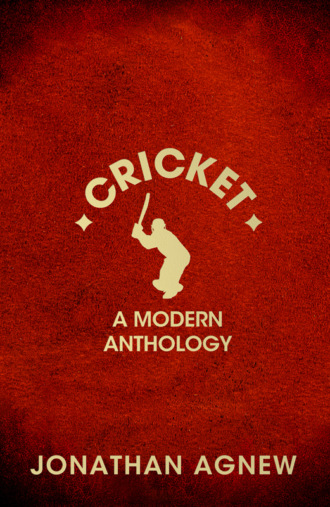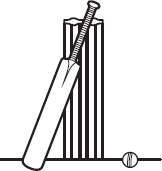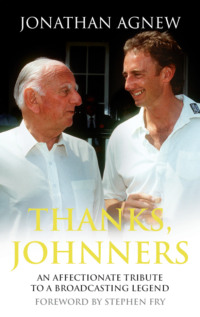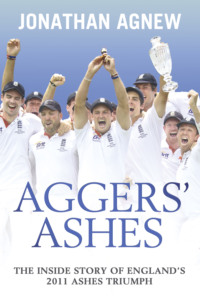
Полная версия
Cricket: A Modern Anthology

About the Book
“It would be a great shame if cricket writing became exclusively the domain of former first-class cricketers. While we bring insight, knowledge and experience of the game that can only be gained from actually having been out there and done it, there is much more to cricket writing than that.”
Indeed there is, and who better to present a new collection of the best cricket writing of the modern era than today’s ‘voice of cricket’. As a young boy watching his newly-discovered cricketing heroes on a grainy black-and-white television, Jonathan Agnew quickly fell in love with the game and went on to pursue a career as a professional player who represented his country before becoming one of the outstanding broadcasters of his generation.
Taking the infamous 1932/33 Ashes ‘Bodyline’ series as his starting point, Agnew or, as he is better known, “Aggers”, selects the most entertaining, crafted and varied cricket writing to illuminate his personal reflections on a series of topics that dissect and explore the modern game from the era of Bradman and Larwood up to the present day.
Cricket: A Modern Anthology features a wide range of contributors including John Arlott, Neville Cardus, Mike Brearley, Simon Hughes, Michael Atherton, Jim Maxwell, Marcus Berkmann, Richie Benaud and Geoffrey Moorhouse.
This is a book brimming with personality and depth that sheds considerable light on the enduring fascination with, arguably, the greatest game ever played.
About the Author
Jonathan Agnew was born in Macclesfield, Cheshire and brought up on a farm in Stamford, Lincolnshire. He went to Uppingham School before becoming a professional cricketer with Leicestershire. He went on to play 218 matches for his county, taking 666 first-class wickets, including five in an innings on 37 occasions. He played three Tests and three one-day internationals for England and was named one of Wisden’s five Cricketers of the Year in 1988.
He retired in 1990 to become cricket correspondent of the Today newspaper and the following year succeeded Christopher Martin-Jenkins as the BBC’s cricket correspondent. He won the Sony Radio award for Best Reporter in 1992 and in 1994, following the death of Brian Johnston, became the presenter of Test Match Special, commentating and reporting on the England cricket team around the world. In 2010, the Association of Sports Journalists named Agnew Best Radio Broadcaster of the Year, the same year that Test Match Special also won Best Radio Programme.
Jonathan has toured the world for 22 years as a cricket correspondent. He lives in the Vale of Belvoir with his wife Emma, four dogs and a cat.
CRICKET
A Modern Anthology
Jonathan Agnew

This book is dedicated to the memory of
Christopher Martin-Jenkins, who, through
his skilful broadcasting, prolific writing
and boundless love of the game, was
cricket’s greatest friend.
Contents
About the Book
About the Author
Title Page
Dedication
The Illustrations
Foreword by Rt Hon Sir John Major KG CH
Preface
Chapter 1: The Great Controversies
Sir Donald Bradman: Farewell to Cricket
Duncan Hamilton: Harold Larwood
Wisden Cricketers’ Almanack 1934: The Bowling Controversy – Text of the Cables
Sydney J. Southerton’s Analysis
Christopher Douglas: Jardine, A Spartan Cricketer
Basil D’Oliveira: The Basil D’Oliveira Affair
Wisden Cricketers’ Almanack 2012: The Obituary of Basil D’Oliveira
Sir Derek Birley: A Social History of English Cricket
David Tossell: Grovel! The Story and Legacy of the Summer of 1976
Paul Nixon: Keeping Quiet: The Autobiography
Martin Johnson: Can’t Bat, Can’t Bowl, Can’t Field
Ed Hawkins: Bookie Gambler Fixer Spy: A Journey to the Heart of Cricket’s Underworld
Vaibhav Purandare: Sachin Tendulkar: The Definitive Biography
Gideon Haigh: Sphere of Influence: Writings on Cricket and its Discontents
Steve James: The Plan: How Fletcher and Flower Transformed English Cricket
Chapter 2: The Greatest Test Matches
Richie Benaud: A Tale of Two Tests: With Some Thoughts on Captaincy
Ray Robinson: The Wildest Tests
Denzil Batchelor: Games of a Lifetime
Rob Steen: 500–1: The Miracle of Headingley ’81
Mike Brearley: The Art of Captaincy
Chapter 3: The Professional
Leo McKinstry: Jack Hobbs: England’s Greatest Cricketer
Max Davidson: We’ll Get ’Em in Sequins: Manliness, Yorkshire Cricket and the Century That Changed Everything
John Arlott: Fred: Portrait of a Fast Bowler
Chris Waters: Fred Trueman: The Authorised Biography
Amol Rajan: Twirlymen: The History of Cricket’s Greatest Spin Bowlers
Geoffrey Boycott: Boycott On Cricket
Mike Brearley: The Art of Captaincy
Simon Wilde: Ian Botham: The Power and the Glory
Phil Tufnell: The Autobiography: What Now?
Simon Hughes: A Lot of Hard Yakka
Matthew Hayden: Standing My Ground
Chapter 4: Gentlemen and Players
Geoffrey Moorhouse: The Best Loved Game
Harry Pearson: Slipless in Settle: A Slow Turn Around Northern Cricket
Harry Thompson: Penguins Stopped Play
Marcus Berkmann: Rain Men: The Madness of Cricket
Marcus Berkmann: Zimmer Men: The Trials and Tribulations of the Ageing Cricketer
Michael Simkins: Fatty Batter: How Cricket Saved My Life (Then Ruined It)
R. Chandrasekar: The Goat, the Sofa and Mr Swami
Chapter 5: The Pen is Mightier Than the Bat
Sir John Major: More Than A Game: The Story of Cricket’s Early Years
R. C. Robertson-Glasgow: 46 Not Out
Sir Neville Cardus: Days in the Sun
Richie Benaud: Willow Patterns
John Arlott: Indian Summer
Timeri N. Murari: The Taliban Cricket Club
Gideon Haigh: Sphere of Influence: Writings on Cricket and its Discontents
Christopher Martin-Jenkins: CMJ: A Cricketing Life
Picture Section
Footnotes
Acknowledgements
Also by Jonathan Agnew
Read on for an extract from Thanks, Johnners. Out now
Copyright
About the Publisher
The Illustrations
Section 1
The scoreboard at the end of England’s first innings of the opening Test, Sydney, December 1932
Harold Larwood bowling to Bill Woodfull during the Fourth Test, Brisbane, February 1933
Basil D’Oliveira batting for England against Australia in the Fifth Test at the Oval, August 1968
Henry Olonga bowling for Zimbabwe against India in the World Cup in England, May 1999
Australia’s Jeff Thomson bowling to Tony Greig during the Fourth Test, Sydney, January 1975
Michael Holding of West Indies bowling to Brian Close during the Second Test at Lord’s, June 1976
Kerry Packer and Tony Greig outside the High Court in London, September 1977
Cricket under lights at the World Series Grand Final, Sydney, February 1979
Captains Alec Stewart of England and Hansie Cronje of South Africa toss up before the Second Test at Lord’s, June 1998
Allan Donald stares down Michael Atherton during the Fourth Test at Trent Bridge, July 1998
The first ever tied Test, Australia v West Indies, Brisbane, December 1960
Mark Boucher celebrates as the scoreboard shows South Africa have overtaken Australia’s record ODI score of 434, Johannesburg, March 2006
Ian Botham hooking Geoff Lawson during his innings of 149 not out in the Third Test at Headingley, July 1981
Bob Willis prepares to bowl during Australia’s second innings when he took eight for 43 to win the match, Headingley, July 1981
Ian Botham shakes hands with his captain Mike Brearley as England win the Fourth Test at Edgbaston by 29 runs, August 1981
Geoff Miller catches last man Jeff Thomson to win the Fourth Test against Australia by two runs, Melbourne, December 1982
West Indies’ Courtney Walsh celebrates a one-run victory against Australia in the Fourth Test, Adelaide, January 1993
Section 2
South African captain Kepler Wessels leads out his team against West Indies in the inaugural Test between the two sides, Barbados, April 1992
Kenny Benjamin dismisses South Africa’s top scorer Andrew Hudson for 163, Barbados, April 1992
V. V. S. Laxman and Rahul Dravid leave the field having batted all day for India against Australia in the Second Test at Eden Gardens, March 2001
Harbhajan Singh dismisses Shane Warne to claim a hat-trick in Australia’s first innings of the Second Test at Eden Gardens, March 2001
Andrew Flintoff consoles Brett Lee after England had beaten Australia by two runs in the Second Test at Edgbaston, August 2005
Australia’s Glenn McGrath is injured during the warm-up before the start of play at Edgbaston, August 2005
Donald Bradman batting for Australia against England in the First Test at Trent Bridge, June 1948
Harold Larwood, who played only twenty-one Tests for England, and none after the Bodyline tour of 1932–3
Donald Bradman’s last Test innings at the Oval, August 1948
Trevor Bailey batting for England against Australia during the Fifth Test at the Oval, August 1953
Fred Trueman taking his 300th Test wicket during the Fifth Test against Australia at the Oval, August 1964
Australian captain Richie Benaud bowling during the First Test against England, Brisbane, December 1958
Tony Greig bowling for England against India during the Second Test at Lord’s, June 1974
David Steele batting for Northamptonshire, May 1975
Andy Roberts bowling for West Indies during the Second Test against Australia, Perth, December 1975
Ray Illingworth, captain of Leicestershire and previously of England, at the start of the 1974 season
Geoff Boycott scoring his 100th first-class century during the Fourth Test against Australia, Headingley, August 1977
Section 3
Shane Warne bowling England captain Mike Gatting with his first ball in an Ashes Test at Old Trafford, June 1993
Sachin Tendulkar receiving his award for a Test Match Special ‘champagne moment’ from the author during the Second Test at Lord’s, June 1996
Muttiah Muralitharan bowling for Sri Lanka against England during the Second Test in Kandy, December 2003
Graeme Swann bowling for England against Sri Lanka during the Second Test at Lord’s, June 2011
England captain Douglas Jardine at the crease wearing his trademark Harlequin cap
Wally Hammond of Gloucestershire and England
A poster advertising Len Hutton’s benefit match at Scarborough, July 1950
Ted Dexter walking out to bat for Cambridge University, 1958
West Indian cricketers Kenneth Rickards, Frank Worrell, Clyde Walcott, Roy Marshall and Everton Weekes at St Pancras station en route to Australia, September 1951
West Indies fast bowler Charlie Griffith bowling for Burnley in the Lancashire League, August 1964
A game in progress at Belvoir Cricket Club in the evening sunshine
One of many games of cricket played on the vast expanse of open land at the Oval Maidan in Mumbai
Sir Neville Cardus making a typically flamboyant speech
John Arlott bringing his broadcasting career to a close during the Centenary Test between England and Australia at Lord’s in 1980
The late Christopher Martin-Jenkins at home in 2008
Foreword Rt Hon. Sir John Major KG CH
The words ‘cricket’ and ‘Jonathan Agnew’ have become synonymous to cricket lovers, and there can be no better guide to the evolution of the modern game.
It is a big story that deserves – and, in these pages, has – a sure guide.
By 1930, although cricket had matured from the country-house pastime of the pre-Grace years, it was still far from the game we know today. Since then, many more countries have entered the Test arena, and the administration of the game has passed into professional hands and away from gifted amateurs. Out-of-date class distinctions on the field have faded away – but only slowly, with reluctance – and the top-class game has become fully professional. New and shorter forms of cricket have emerged to attract millions of new supporters, alongside the grumbling disapproval of traditionalists.
To them, and to most cricket lovers, the spirit of the game – the way in which it is played – has always been at the heart of its charm. It is a rude shock when controversy enters the arena, and far worse when corruption is uncovered.
Jonathan Agnew’s story begins with the Ashes series of 1932–3. It was on-field cricket at its most distasteful, as the English fast-bowling attack targeted ‘bodyline’ bowling at the Australian batsmen instead of their stumps. It was an unscrupulous tactic to curb the mammoth run scoring of Don Bradman. Today, with television tracking every ball, such a tactic would never survive, but ‘bodyline’ soured a whole series and scarred cricket.
Later, the English cricketing authorities – with an arrogance that, eighty years on, is scarcely believable – ordered Harold Larwood, their fast-bowling spearhead, to apologise. Larwood was entirely right to refuse, saying that he was upholding the instructions of his team captain, Douglas Jardine. But Jardine was a ‘gentleman’ and Larwood was not – and so it was he who was pilloried. It was, in every way, an ugly and shameful episode.
As a fast bowler, Larwood was one of the heroes that cricket throws up in every generation: their reputation becomes enshrined in the folklore of the game, and lasts long after they have left the field of play. Among the most cherished names, Bradman and Sobers may stand alone on their pedestal, but I fancy Shane Warne might one day join them on it. Most of these great cricketers are a credit to the game.
But not all: some heroes have revealed a dark side and been seduced and corrupted by money. Their names need not be repeated here but match-fixing poses a threat the authorities cannot ignore. Some cricket authorities have reacted vigorously to curtail this evil – but all need to do so. The ‘Spirit of Cricket’ is important to lovers of the game, and where that is flouted, they may turn away in disgust. The extent of corruption induced by betting scams is unknowable but, if it is tolerated by any authority, the damage will be acute.
Over recent decades, cricket has been broadcast to a global audience by radio and television. To the avid listener or viewer, the players representing teams on the far side of the world have become as familiar as the stars of their own country. The media coverage is comprehensive, and generally superb.
But cricket is more than a game. For countless millions, it is part of their lives, and given added drama and charm by the skill of the broadcasters. For me, cricket has always been pure pleasure when described by the likes of Rex Alston, John Arlott or Brian Johnston and – more recently – Henry Blofeld, Christopher Martin-Jenkins and the author of this book, Jonathan Agnew – that valuable hybrid of Test cricketer and professional broadcaster. Their sheer love of the game – and the romanticism, sentiment and sheer fun of it that they impart – has woven them into the warp and weft of cricket: it would be sad, indeed, if the contributions of such men were banished from the game.
And, to this observer, that seems a risk. Increasingly, the commentators and summarizers of top-class cricket are former eminent Test players. I welcome their arrival at the microphone because, to this particular cricket lover, they have added an extra dimension of understanding about the game. Their contribution is unique – but I hope it will never be exclusive: a mixture of broadcasters, cricketers and writers may offer the best depiction of the game to listeners and viewers.
In its infancy, cricket spread outwards from England as the British Empire was built. It took root and, as it did so, ceased to be an English game; each country played it in their own distinctive style. As the game spreads further, the focused aggression of the Australians; the Caribbean swagger of the West Indies; the suppleness of the Indians, may yet be joined by the national characteristics of the Afghans and the Chinese. If so, cricket will be the stronger for it.
The question that now arises is – whither cricket? The present growth of the game suggests confidence about its future from the grass roots upwards, with one reservation. The huge appeal of the shorter forms of the game – and the huge money-spinner it has become – means that cricket at the very highest level, five-day Test cricket, must be protected and cherished. It is, to my mind, the finest expression of the game, the peak of its art and, if it were diminished – or even crowded out – by mercenary considerations, then the game itself would surely suffer.
In its long history, cricket has been blessed with great literature: no game has ever attracted so many authors, or so much magnificent writing. In this book, Jonathan Agnew adds to this great canon, and draws on it to illustrate the evolutionary changes of recent decades.
This book is for every lover of cricket who wishes to dig deeper into the history of the game, through the words and sentiments of those who shared – or still share – their passion for it.
March 2013
Preface
Cricket, more than any other sport, has always lent itself to expressive colourful writing alongside intelligent debate – in the sports pages of our daily newspapers, over the broadcasting airwaves, through the pages of Wisden dating back to 1864 or, indeed, around the bar in the village pub. Such is the depth and complexity of cricket – spanning its history, politics and characters – that a single, universal view is extremely rare. Even such momentous events as Bodyline, the D’Oliveira affair and World Series Cricket were all strenuously argued about, usually from diametrically opposed positions.
The beauty of assembling an anthology such as this is that those opinions, assessments and descriptions can all be brought together in one place. So this is where we are able to read about and compare the lifestyles and characters of two of England’s finest fast bowlers, Harold Larwood and Fred Trueman; savour the deeds of opening batsmen Jack Hobbs and my old friend Geoffrey Boycott; consider first-hand reflections on Bodyline by Sir Donald Bradman; and enjoy a graphic description of the first tied Test between Australia and West Indies by Richie Benaud, who lost his wicket to the second ball of that frantic final over delivered by Wes Hall.
To be given the opportunity to sit, read and select extracts from the works of some of cricket’s finest writers and players has been a most rewarding experience. The modern game is so time-consuming – with matches coming thick and fast and increasingly demanding deadlines to hit – that it is difficult sometimes to sit back, take a breath and reflect properly on what has just taken place. However, a book provides the opportunity to include additional information that was not available at the time and that vital element of context, which can only properly be given with the passing of the years. I have frequently found myself surprised as new light is shed on a subject I thought I knew reasonably well. For the first time, for instance, we learn that Basil D’Oliveira was the selectors’ third-choice replacement for the injured Tom Cartwright in 1968; he was definitely not rushed into the squad for that ill-fated tour as the South African government believed.
I am delighted that this book has offered me the chance to explore, and now share, some of the most joyful, illuminating and elegant writing ever produced about cricket – without doubt the best sport in the world.
Jonathan Agnew, March 2013
THE GREAT CONTROVERSIES
‘I have sacrificed cricket’s most coveted job for a cause which I believe could be in the interests of cricket the world over.’
Tony Greig on his transition to Kerry Packer’s World Series Cricket

Tearful Batsman (after defying Umpire’s ruling). ‘All right, I’ll go! But it ain’t cricket. They wouldn’t do that at Lord’s.’

Chapter 1
‘I don’t want to see you, Mr Warner. There are two teams out there; one is trying to play cricket and the other is not.’
Australian captain Bill Woodfull’s disdainful response to the England manager’s suppliant knock on the Australian’s dressing room door during the 1933 Adelaide Test.
Given that cricket is supposed to stand for everything that is decent and upstanding in the world, it is remarkable how often down the years that the ‘sport of gentlemen’ has found itself embroiled in bitter controversies and rancour. It is also surprising how these disagreements quickly escalate far beyond the field of play – even in some cases leading to governmental involvement. Surprising, that is, until you consider the framework of international cricket, and how the sport was taken from the United Kingdom to the far-flung corners of the globe in the first place.




